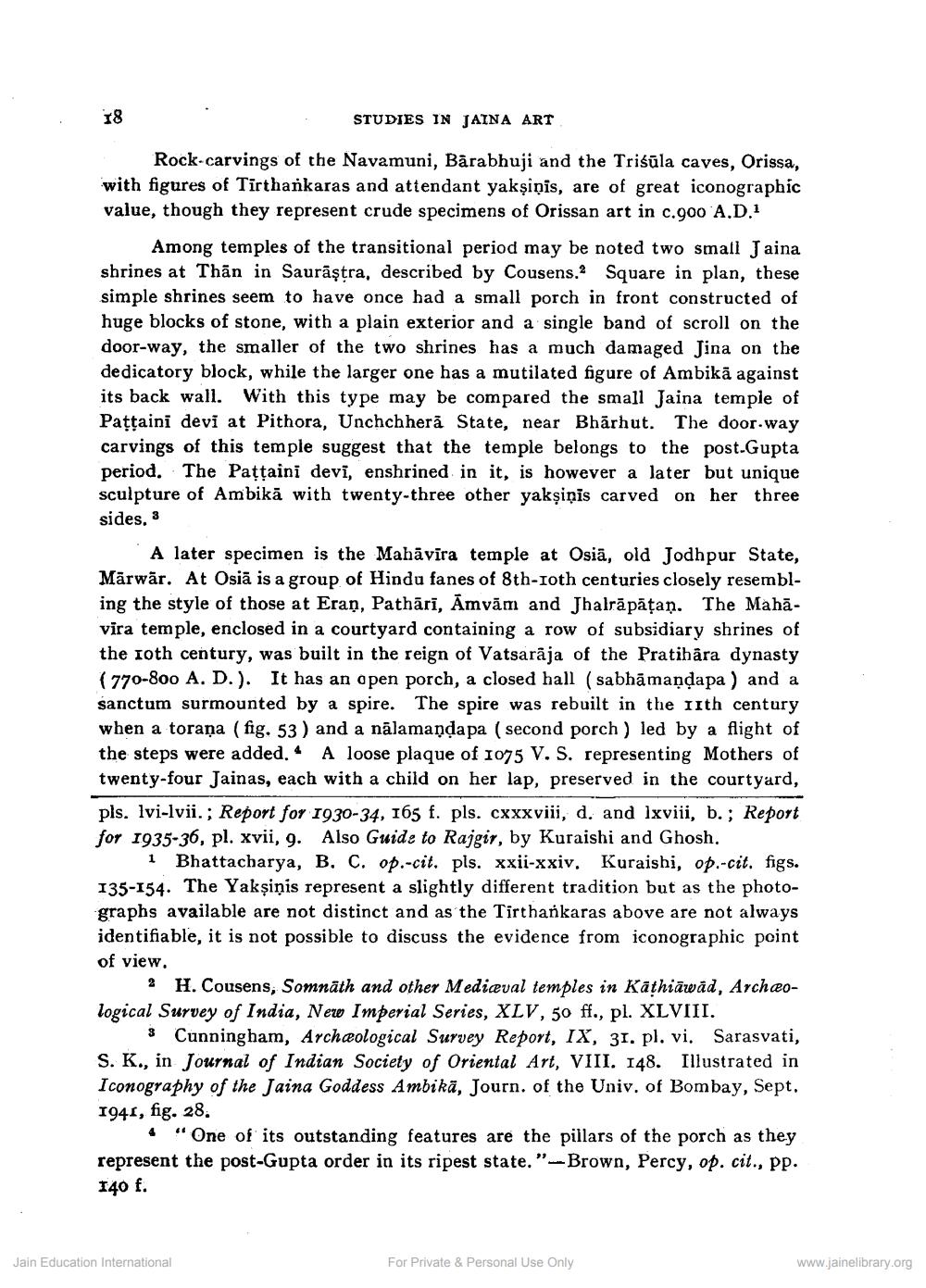________________
STUDIES IN JAINA ART
Rock-carvings of the Navamuni, Bārabhuji and the Trisûla caves, Orissa, with figures of Tirthankaras and attendant yakşinls, are of great iconographic value, though they represent crude specimens of Orissan art in c.900 A.D.1
18
Among temples of the transitional period may be noted two small Jaina. shrines at Than in Saurăştra, described by Cousens. Square in plan, these simple shrines seem to have once had a small porch in front constructed of huge blocks of stone, with a plain exterior and a single band of scroll on the door-way, the smaller of the two shrines has a much damaged Jina on the dedicatory block, while the larger one has a mutilated figure of Ambika against its back wall. With this type may be compared the small Jaina temple of Paṭṭaini devi at Pithora, Unchchherå State, near Bhärhut. The door way. carvings of this temple suggest that the temple belongs to the post-Gupta period. The Paṭṭaini devi, enshrined in it, is however a later but unique sculpture of Ambika with twenty-three other yakṣiņis carved on her three sides, 3
A later specimen is the Mahavira temple at Osiä, old Jodhpur State, Mārwar. At Osia is a group of Hindu fanes of 8th-10th centuries closely resembling the style of those at Eran, Pathārī, Amväm and Jhalrāpāțan. The Mahāvira temple, enclosed in a courtyard containing a row of subsidiary shrines of the 10th century, was built in the reign of Vatsaraja of the Pratihāra dynasty (770-800 A. D.). It has an open porch, a closed hall (sabhamandapa) and a sanctum surmounted by a spire. The spire was rebuilt in the 11th century. when a torana (fig. 53) and a nalamandapa (second porch) led by a flight of the steps were added. A loose plaque of 1075 V. S. representing Mothers of twenty-four Jainas, each with a child on her lap, preserved in the courtyard, pls. lvi-lvii.; Report for 1930-34, 165 f. pls. cxxxviii, d, and lxviii, b.; Report for 1935-36, pl. xvii, 9. Also Guide to Rajgir, by Kuraishi and Ghosh.
1 Bhattacharya, B. C. op.-cit. pls. xxii-xxiv. Kuraishi, op. cit. figs. 135-154. The Yakṣiņis represent a slightly different tradition but as the photographs available are not distinct and as the Tirthankaras above are not always identifiable, it is not possible to discuss the evidence from iconographic point of view,
* H. Cousens, Somnath and other Mediaeval temples in Kathiawad, Archaological Survey of India, New Imperial Series, XLV, 50 ff., pl. XLVIII.
Cunningham, Archeological Survey Report, IX, 31. pl. vi. Sarasvati, S. K., in Journal of Indian Society of Oriental Art, VIII. 148. Illustrated in Iconography of the Jaina Goddess Ambika, Journ. of the Univ. of Bombay, Sept. 1944, fig. 28.
"One of its outstanding features are the pillars of the porch as they represent the post-Gupta order in its ripest state."-Brown, Percy, op. cit., pp. 140 f.
Jain Education International
For Private & Personal Use Only
www.jainelibrary.org




